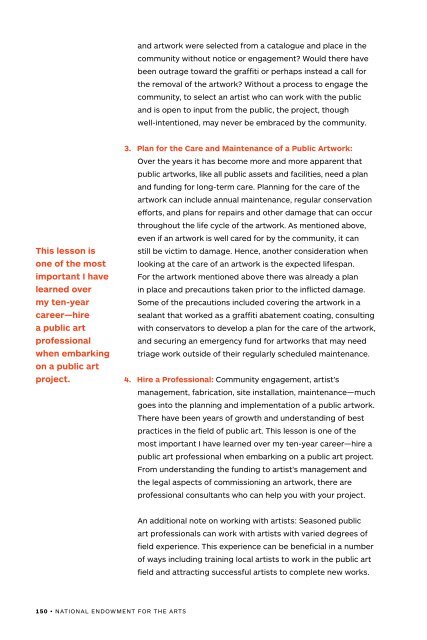placemaking
8myXe6Hx8
8myXe6Hx8
Create successful ePaper yourself
Turn your PDF publications into a flip-book with our unique Google optimized e-Paper software.
and artwork were selected from a catalogue and place in the<br />
community without notice or engagement? Would there have<br />
been outrage toward the graffiti or perhaps instead a call for<br />
the removal of the artwork? Without a process to engage the<br />
community, to select an artist who can work with the public<br />
and is open to input from the public, the project, though<br />
well-intentioned, may never be embraced by the community.<br />
This lesson is<br />
one of the most<br />
important I have<br />
learned over<br />
my ten-year<br />
career—hire<br />
a public art<br />
professional<br />
when embarking<br />
on a public art<br />
project.<br />
3. Plan for the Care and Maintenance of a Public Artwork:<br />
Over the years it has become more and more apparent that<br />
public artworks, like all public assets and facilities, need a plan<br />
and funding for long-term care. Planning for the care of the<br />
artwork can include annual maintenance, regular conservation<br />
efforts, and plans for repairs and other damage that can occur<br />
throughout the life cycle of the artwork. As mentioned above,<br />
even if an artwork is well cared for by the community, it can<br />
still be victim to damage. Hence, another consideration when<br />
looking at the care of an artwork is the expected lifespan.<br />
For the artwork mentioned above there was already a plan<br />
in place and precautions taken prior to the inflicted damage.<br />
Some of the precautions included covering the artwork in a<br />
sealant that worked as a graffiti abatement coating, consulting<br />
with conservators to develop a plan for the care of the artwork,<br />
and securing an emergency fund for artworks that may need<br />
triage work outside of their regularly scheduled maintenance.<br />
4. Hire a Professional: Community engagement, artist’s<br />
management, fabrication, site installation, maintenance—much<br />
goes into the planning and implementation of a public artwork.<br />
There have been years of growth and understanding of best<br />
practices in the field of public art. This lesson is one of the<br />
most important I have learned over my ten-year career—hire a<br />
public art professional when embarking on a public art project.<br />
From understanding the funding to artist’s management and<br />
the legal aspects of commissioning an artwork, there are<br />
professional consultants who can help you with your project.<br />
An additional note on working with artists: Seasoned public<br />
art professionals can work with artists with varied degrees of<br />
field experience. This experience can be beneficial in a number<br />
of ways including training local artists to work in the public art<br />
field and attracting successful artists to complete new works.<br />
150 • NATIONAL ENDOWMENT FOR THE ARTS


